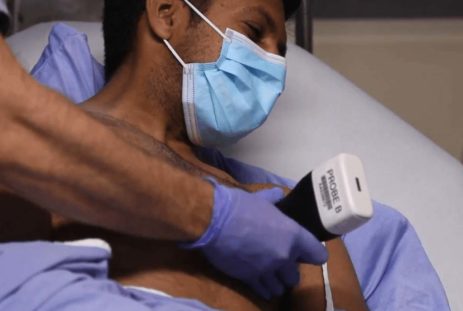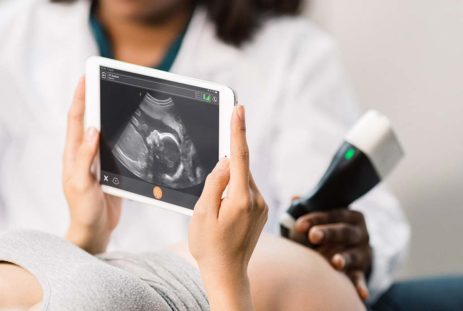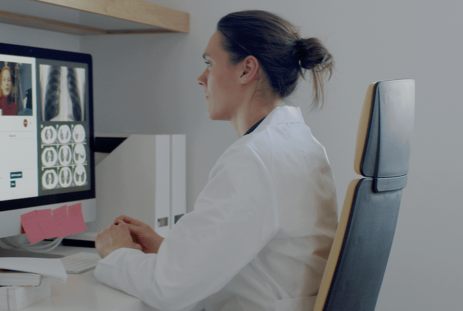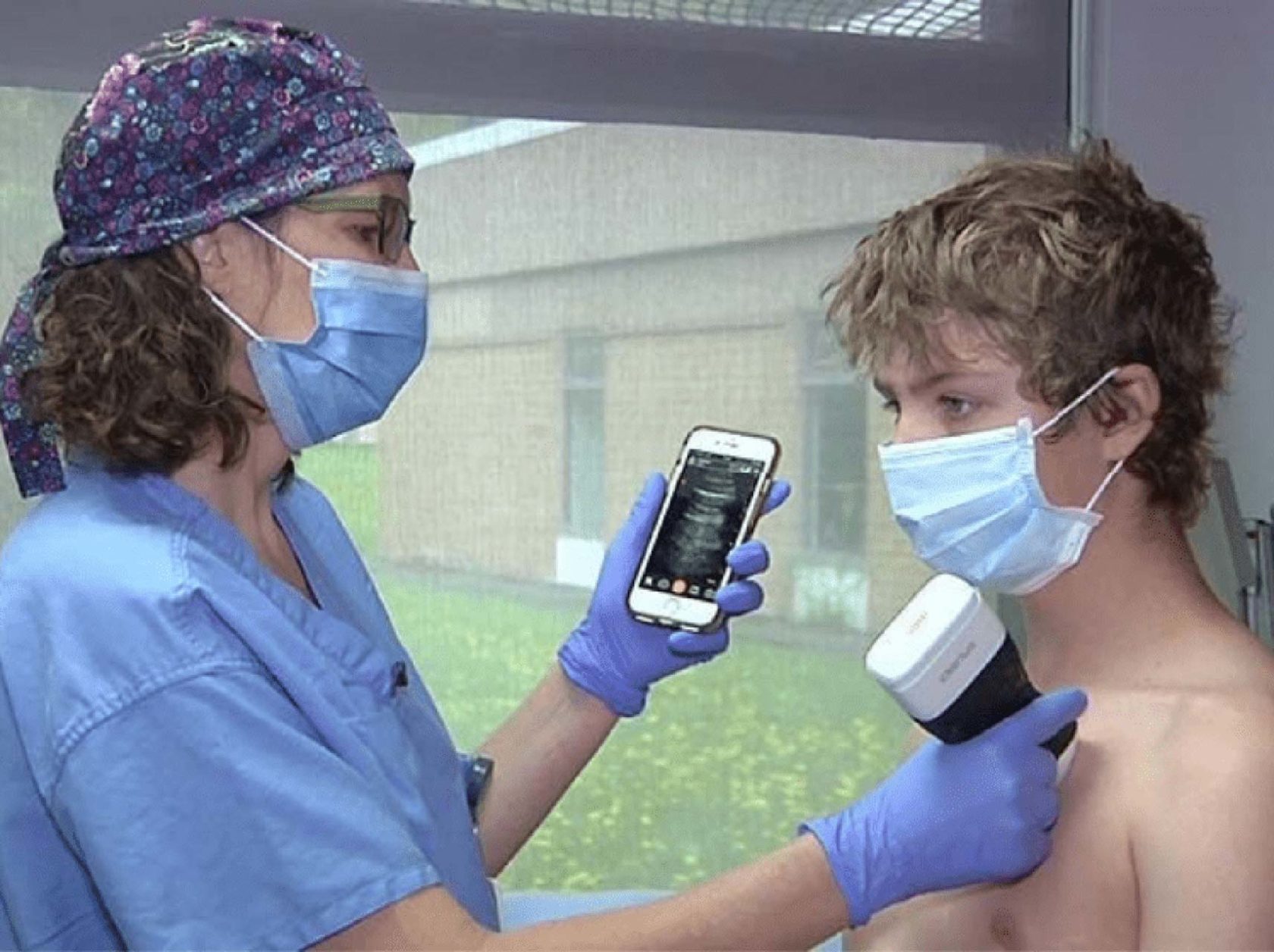
Enhancing Rural Healthcare with Mobile Ultrasound Scanners
AN IMPACT STORY
Improving health services in rural and remote indigenous communities
Ultrasound is an essential clinical tool that can provide early diagnosis of many medical conditions, from heart conditions and pre-natal risks to identifying lung abnormalities that may indicate the presence of COVID-19. Traditional ultrasound devices are large, bulky machines found mostly in large urban health centers. Citizens in remote or rural communities need to travel sometimes hundreds of kilometers to access this critical health service.
The Intelligent Network for Point-of-Care Ultrasound project has revolutionized access to ultrasound by developing handheld ultrasound devices powered by artificial intelligence. These advanced tools combine machine-learning technology, portable devices and a cloud-based platform to create an integrated point-of-care network that ensures accurate diagnoses for Canadians while reducing the need for specialized training. This means that citizens in Nelson, Haida Gwaii and other remote and indigenous communities in BC now have access to ultrasound.
“It’s about democratizing healthcare and eliminating the discrepancy between the quality of care in rural and urban areas,” explains Professor Purang Abolmaesumi of the University of British Columbia, one of the seven organizations collaborating on the project. “For the first time, we have integrated handheld ultrasound devices into a unified AI-powered platform that provides the medical data and image quality needed by physicians in every part of the province.”
Dr. Jennifer Kask, a family physician with North Island Hospital, has been able to see and treat multiple women in communities such as Campbell River and Port Hardy. “I love it. I take it everywhere with me, just like I take my stethoscope and pen to the office every day,” she adds. “The portable scanners have become a critical part of my toolbox.”
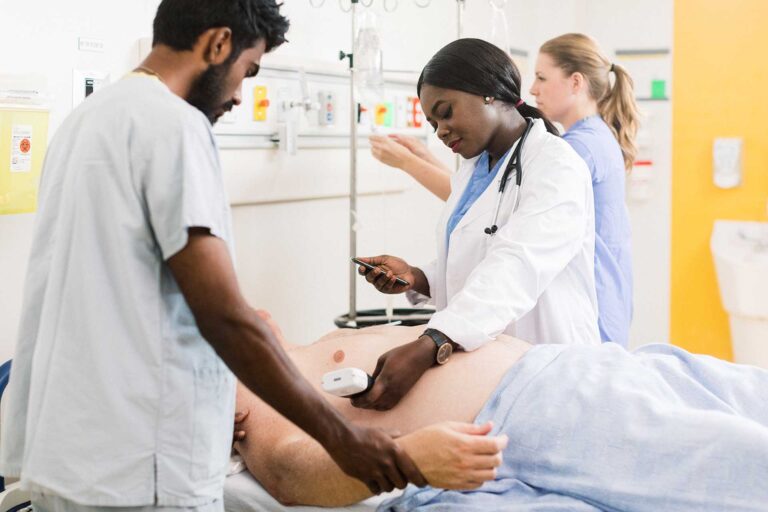
When COVID-19 hit, the project team immediately considered the potential to expand the application of the handheld ultrasound devices from heart and pregnancy related conditions, to speeding up the detection of lungs being compromised by COVID-19. The team pivoted quickly and the Point-of-Care Ultrasound (POCUS) for COVID-19 project came to life.
“The Digital Supercluster has helped Providence forge new pathways to work with industry partners in developing technology driven solutions for complex health issues, said Brian Simmers, CFO and VP of People & Health Informatics at Providence Health Care. “In this collaborative innovation model, the projects we have engaged in highlight the thought leadership and strategic value-add we bring to the consortium, which supports the development of intellectual property and co-developed solutions. Supercluster uniquely enables all partners to come together at the table and navigate challenging but important intellectual property ownership and commercialization arrangements.”
With impressive speed, project members Providence Health Care (Project Lead), Change Healthcare, Clarius Mobile Health, the University of British Columbia, St. Paul’s Foundation, and the Rural Coordination Centre of B.C. (RCCBC) joined forces to deploy more than 80 Clarius portable handheld ultrasound scanners in remote communities and long-term care homes across the province.
“The establishment of the COVID network means physicians have been able to share their images with any specialist and receive immediate feedback,” explains Dr. Virginia Robinson of the Fernie-based Rural Coordination Centre. “Ultrasound has been a game-changer for rural care in general, allowing immediate diagnoses for triaging and expediting trauma cases to higher levels of care.”
With only 5 percent of B.C. physicians having achieved the minimum competency required to interpret scans, sharing data and expertise through the network will provide even novice ultrasound users with vital information, Dr. Robinson added, and will help reduce the delays and other difficulties affecting up to 40 percent of the province’s diagnostic imaging tests. At the same time, the project is assembling Canada’s first ultrasound library for lung diseases including COVID-19.
Dr. Robinson says the Supercluster has generated “a cooperative intelligence” that she describes as the ability for its members to leverage each other’s diverse areas of expertise to develop new technologies that improve patient care.
In rural and Indigenous communities that lack specialty care and face challenges in getting timely diagnosis, the POCUS project is having the biggest impact, Dr. Robinson says. “Some of our most rural communities are Indigenous, and they are now benefiting. Physicians can use these portable ultrasound devices to distinguish between small issues and emergencies, and this can save lives.”
Over the last four months, 52 probes have been deployed in 32 rural communities, including 12 Indigenous communities.
Travel costs incurred by the health system and by individuals is also coming down. Transferring a patient from a rural setting to a city for urgent diagnostic imaging costs up to $20,000, while patients are also out of pocket when they travel for non-urgent care. “For patients, physicians and the healthcare system, this is an incredible development,” says Dr. Robinson.
In addition, POCUS is allowing physicians to treat underserved communities and underrepresented groups that may not have traditionally showed up at the hospital or the clinic. “Our ability to reach people who might not present themselves otherwise is also really beneficial,” Dr. Robinson explains.
The POCUS project is also positioning B.C. and Canada as leaders in healthcare education through the use of handheld ultrasound devices. “Ultrasound has been around for a while, including some portable ultrasound, but B.C.’s approach in creating a system and community of practice where we can share and learn from each other is going to elevate us and ensure long-term benefits,” says Dr. Robinson.
Learn about the COVID Project“It’s important that we recognize the toll the COVID-19 pandemic has taken on people in B.C., especially those who have lost loved ones, however it has also brought out the best in our province when it comes to state-of-the-art techniques to help in the battle against this deadly virus,” said Adrian Dix, Minister of Health. “The Point-of-Care Ultrasound project has been quickly re-purposed to potentially detect COVID-19 in people and I’m proud that our government supports this type of important innovation.”
